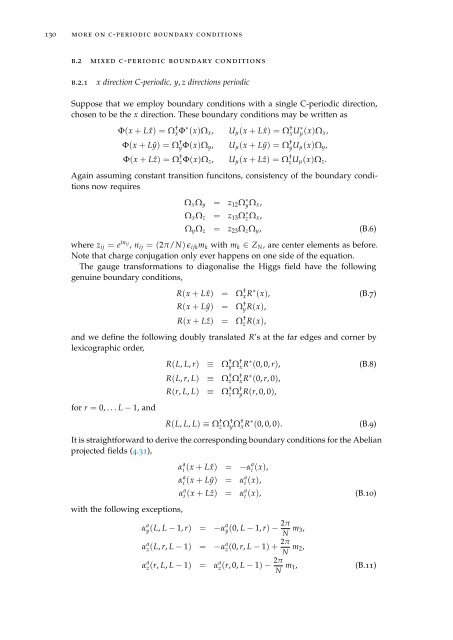Topology, symmetry, and phase transitions in lattice gauge ... - tuprints
Topology, symmetry, and phase transitions in lattice gauge ... - tuprints
Topology, symmetry, and phase transitions in lattice gauge ... - tuprints
Create successful ePaper yourself
Turn your PDF publications into a flip-book with our unique Google optimized e-Paper software.
130 more on c-periodic boundary conditions<br />
b.2 mixed c-periodic boundary conditions<br />
b.2.1<br />
x direction C-periodic, y, z directions periodic<br />
Suppose that we employ boundary conditions with a s<strong>in</strong>gle C-periodic direction,<br />
chosen to be the x direction. These boundary conditions may be written as<br />
Φ(x + L ˆx) = Ω † xΦ ∗ (x)Ω x , U µ (x + L ˆx) = Ω † xU ∗ µ(x)Ω x ,<br />
Φ(x + Lŷ) = Ω † yΦ(x)Ω y , U µ (x + Lŷ) = Ω † yU µ (x)Ω y ,<br />
Φ(x + Lẑ) = Ω † zΦ(x)Ω z , U µ (x + Lẑ) = Ω † zU µ (x)Ω z .<br />
Aga<strong>in</strong> assum<strong>in</strong>g constant transition funcitons, consistency of the boundary conditions<br />
now requires<br />
Ω x Ω y = z 12 Ω ∗ yΩ x ,<br />
Ω x Ω z = z 13 Ω ∗ zΩ x ,<br />
Ω y Ω z = z 23 Ω z Ω y , (B.6)<br />
where z ij = e <strong>in</strong> ij<br />
, n ij = (2π/N) ɛ ijk m k with m k ∈ Z N , are center elements as before.<br />
Note that charge conjugation only ever happens on one side of the equation.<br />
The <strong>gauge</strong> transformations to diagonalise the Higgs field have the follow<strong>in</strong>g<br />
genu<strong>in</strong>e boundary conditions,<br />
R(x + L ˆx) = Ω † xR ∗ (x), (B.7)<br />
R(x + Lŷ) = Ω † yR(x),<br />
R(x + Lẑ) = Ω † z R(x),<br />
<strong>and</strong> we def<strong>in</strong>e the follow<strong>in</strong>g doubly translated R’s at the far edges <strong>and</strong> corner by<br />
lexicographic order,<br />
for r = 0, . . . L − 1, <strong>and</strong><br />
R(L, L, r) ≡ Ω † yΩ † xR ∗ (0, 0, r), (B.8)<br />
R(L, r, L) ≡ Ω † zΩ † xR ∗ (0, r, 0),<br />
R(r, L, L) ≡ Ω † zΩ † yR(r, 0, 0),<br />
R(L, L, L) ≡ Ω † zΩ † yΩ † xR ∗ (0, 0, 0).<br />
(B.9)<br />
It is straightforward to derive the correspond<strong>in</strong>g boundary conditions for the Abelian<br />
projected fields (4.31),<br />
with the follow<strong>in</strong>g exceptions,<br />
α a i (x + L ˆx) = −αa i (x),<br />
α a i (x + Lŷ) = αa i (x),<br />
αi a(x + Lẑ) = αa i (x), (B.10)<br />
α a y(L, L − 1, r) = −α a y(0, L − 1, r) − 2π N m 3,<br />
α a z(L, r, L − 1) = −α a z(0, r, L − 1) + 2π N m 2,<br />
α a z(r, L, L − 1) = α a z(r, 0, L − 1) − 2π N m 1, (B.11)
















